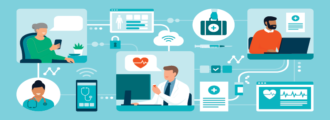If there’s one good healthcare development that emerged from the coronavirus crisis a few years ago, it’s telehealth. By taking advantage of a technology that many people already have at home, healthcare providers have improved the efficiency of care, delivered faster diagnoses and treatments, and reduced the spread of deadly viruses like COVID-19.
According to a McKinsey & Company study, telehealth use in the U.S. jumped from 11 percent in 2019 to 46 percent, ultimately replacing in-person healthcare visits. The report also revealed that telehealth could grow to a $250 billion revenue opportunity given the ever-increasing need for access to health care providers anytime, anywhere through remote monitoring and virtual visits.
Not only are there many benefits to telehealth for patients (not having to travel anywhere, avoiding having to wait in an office, etc.), but there are also significant benefits for healthcare providers who adopt connected health telecommunications technology. Read on to learn a bit more about telehealth and the advantages it can bring to healthcare providers.
What is Telehealth?
First, let’s make sure we’re all on the same page. The Center for Connected Health Policy defines telehealth as “a collection of means or methods for enhancing healthcare, public health, and health education delivery and support using telecommunications technologies.”
Telehealth encompasses various telecommunications technologies and tactics for delivering virtual medical, health, and education services and improving patient outcomes and engagement throughout their care lifecycle.
You might hear people refer to it as “telemedicine” when talking about traditional clinical diagnosis and monitoring delivered by technology. Still, the term “telehealth” is used to describe the full range of diagnosis and management, education, and other related fields of health care.
3 Key Benefits of Telehealth for Healthcare Providers
For healthcare providers, virtual visits allow physicians to work more efficiently, increase patient engagement, and deliver collaborative medical services across the care lifecycle. Here are a few more benefits you stand to gain by adopting telehealth:
Improved Patient Outcomes and Satisfaction
Telehealth can tremendously improve patient quality outcomes, especially for patients with chronic conditions and those who live in rural areas. Access to quality specialists without the need to travel long distances opens up new care opportunities for people outside major cities, making healthcare more accessible and improving health outcomes in situations with limited healthcare exposure.
During the current COVID-19 pandemic, telehealth became crucial to help limit the spread of the virus, especially for patients at a higher risk for complications. On top of all these benefits, what patient wouldn’t be delighted that they don’t have to deal with travel troubles (such as traffic or getting a ride) or waiting in the office to be seen by the doctor?
Reducing Patient No-Show Rates
Speaking of travel troubles, those patients who do miss appointments tend to do so because they don’t have reliable transportation to get them to and from the doctor’s office, an issue that’s especially prevalent in older patients with mobility challenges or disabilities that make access to a healthcare facility difficult. Telehealth removes that barrier of travel and the costs associated with it, and in return, you’ll see fewer people missing appointments.
Reduced Costs
Providers who offer telehealth services find that they can reduce operating costs (they require less front desk support or office space, for example) and use their resources more efficiently. Telehealth also provides flexibility in hours of operation to meet the needs of your patient population, especially if they’re located farther away from your physical location.
Getting Started With Telehealth
If you’re ready to get started with or enhance your telehealth operation, Surety Systems can help.
Our HIT consulting group specializes in healthcare integration, ensuring that your EHR, physicians, practices, patient portals, and clinical team all remain connected and able to help your patients during our current pandemic and afterward. As an unbiased and vendor-neutral integration partner, we aim to help you with your healthcare interoperability project needs and challenges and ensure your internal teams are prepared for continuous improvement over time.
Contact us today to learn how to get started in this new virtual world of healthcare.
Frequently Asked Questions
What is telehealth technology?
Telehealth technology uses digital information and communication tools like computers, smartphones, and mobile applications to provide and manage healthcare services remotely. It encompasses a range of services, including video consultations, remote monitoring, patient education, and electronic health record (EHR) access.
What are the key features to look for in a telehealth platform?
Key features include secure and compliant video conferencing capabilities, seamless integration with EHR systems, user-friendly interfaces for providers and patients, robust data security measures, scalability to accommodate practice growth, and tools for scheduling, billing, and documentation. Additional features such as remote monitoring, patient portals, and interoperability with other healthcare systems can further enhance the effectiveness of a telehealth platform.
What are the challenges healthcare providers may face when implementing telehealth technology?
Challenges include ensuring patient privacy and data security, navigating regulatory and reimbursement policies, integrating telehealth solutions with existing EHR systems, managing the digital divide among patients who may lack access to the necessary technology, and addressing resistance to change among patients and healthcare staff.
How does telehealth benefit healthcare providers?
Telehealth technology increases access to patients, especially those in remote or underserved areas; improves efficiency and convenience in scheduling and conducting appointments; reduces overhead costs associated with in-person visits; enhances patient engagement and satisfaction; and the ability to provide timely care, especially for follow-ups and chronic condition management.




